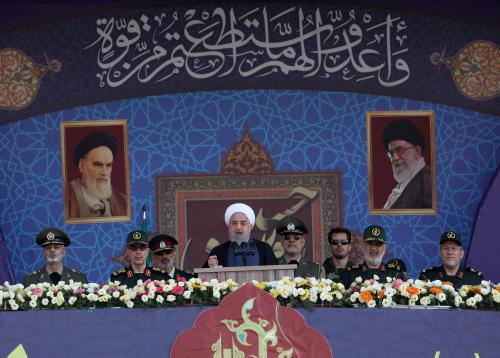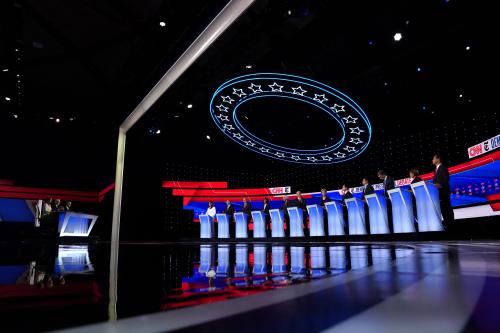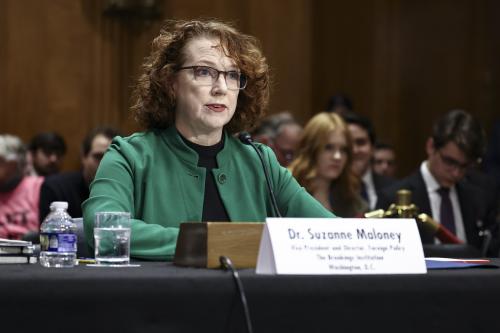Unlike many other countries, America has been blessed by two oceans and two friendly countries on its borders. Because of this, foreign affairs do not typically figure prominently in American electoral politics except when Americans are in danger for one reason or another. In the late 1970s, the American public had little knowledge of Iran, the shah, Islam, or terrorism. That would all change on November 4, 1979, when radical Iranian students took over the U.S. embassy in Tehran and held 52 Americans hostage for 444 days. The Iranian revolution and the hostage crisis would take down President Jimmy Carter and make Americans aware of a part of the world and the roiling tensions within it that are still part of our politics today.
When the shah fell, I was working at the Democratic National Committee, getting ready for the 1980 presidential election. The turmoil in Iran and the fall of the shah had, frankly, very little impact on American politics. In fact, what I remember from that period of time is the Jules Feiffer cartoon with a series of men in Middle Eastern dress lined up. And the gist of the cartoon was: Who knows the difference? Shiites, Sunnis, the differences between them, what their enmity meant to the region: Most Americans remained unaware of the religious and political nuances of the region.
Most of that changed when the hostages were taken. Suddenly, this heretofore unknown country burst into the public’s consciousness. There was the initial, predictable burst of patriotism. A 1973 hit by Tony Orlando and Dawn about a prisoner coming home, called “Tie a Yellow Ribbon ‘Round the Ole Oak Tree,” was appropriated to the hostage situation, and all over the land people began tying yellow ribbons on their trees.
At the center of this was President Carter, whose bid for reelection in 1980 was already being complicated by a primary challenge from Senator Ted Kennedy (D-Mass). Carter immediately suspended foreign travel and political campaigning to focus on the crisis. But there was no diplomatic solution to be had. And what came to be known as “the Rose Garden strategy” (referring to the White House Rose Garden) turned into a trap for the president. Stu Eizenstat, one of Carter’s top aides and the author of the book “President Carter: The White House Years,” writes that the Rose Garden strategy “had another unintended and deeply pervasive effect. It totally personalized the crisis in the American media by focusing the responsibility on the Oval Office and showing the terrorists they could put the American presidency itself into dysfunction.”
Carter initially tried negotiating with Iran’s government that had been thrown into new disarray by the hostage seizure. But given that it was Carter who had invited the shah into the United States, the students who were in control were not inclined to let him off the hook. Furthermore, Ayatollah Ruhollah Khomeini was calling the shots, and he opposed any early settlement. So month after month, as Carter was trapped in the White House, negotiations went nowhere. This is why, in the spring, he decided to mount a military rescue of the hostages.
Operation Eagle Claw was a disaster that ended with American deaths, ruined military planes, and the hostages no closer to freedom. The phone at my house rang early in the morning on April 25, 1980. It was Rick Hernandez, one of the president’s senior political aides, who had heard about the aborted mission and subsequent disaster. He opened the conversation with, “We just lost the election.” I was confused. It was the middle of the night, and, moreover, Carter had just beaten Kennedy in a string of southern primaries and had tied him in the Pennsylvania primary. Rick proceeded to describe, in fairly accurate terms, the debacle in the desert.
All of this happened at a very crucial time in the election cycle. The Carter-Kennedy fight was big news, and voters were just tuning in. To put these events in context, it is also important to remember that Americans had been enchanted with the story of the Israeli raid on Entebbe in 1976. This is one of the first special operations missions that burst into the public consciousness. The dramatic and stunning Israeli rescue of hostages who had been taken by Palestinians in Uganda captured the public imagination. Four years later, the United States tried its own daring rescue and fell flat on its face. That was devastating to Carter. And I believe to this day that my friend Rick Hernandez was right. Carter lost the election that night.
The failed mission was the last straw. Going into 1980, Jimmy Carter was seen as a weak and feckless president. The economy was going extraordinarily badly. His approval ratings were in the toilet. And the challenge from Kennedy, a lion of the Democratic Party, was the toughest nomination challenge any incumbent Democrat had had in many years. Although Carter won the Democratic nomination, he lost all but six states plus the District of Columbia to Ronald Reagan in November. By then, the Iranian students had played out their hand. They had held the hostages for longer than anyone (including themselves) had expected. The hostages were released on January 20, 1981 — the day Ronald Reagan was inaugurated.
On a brighter note, the disastrous rescue mission had tremendous consequences for reform in the U.S. military. It should be noted that at the time of the attempted hostage rescue mission in 1980, there was no unified Special Operations Command in the U.S. military to coordinate the various commands and agencies involved in special operations warfare. In fact, these elements of U.S. military power were, after the wind-down of the Vietnam War, generally underfunded and mistrusted within the military establishment.
The failure of Operation Eagle Claw changed that. It was the straw that broke the camel’s back when it came to military reform. Remember, this happened in 1980. Carter lost the election resoundingly to Ronald Reagan. And in 1985, the Senate began to look at a major military reform bill. Reformers faced intense opposition within the military, particularly from the Navy, and they also faced opposition from Reagan’s secretary of defense. But it was clear that the failure of Operation Eagle Claw, in addition to Vietnam and several other smaller failures, contributed to a point in history where people said, it is time to do something with the United States military when the greatest power in the world cannot manage to rescue its own people.
So remarkably, after 40 years of trying, in 1986 Congress passed the Goldwater-Nichols Department of Defense Reorganization Act, and Reagan signed it. That reorganization and the revival of special operations eventually transformed the American military from Operation Eagle Claw to Operation Neptune Spear (the successful operation that found and killed Osama bin Laden in 2011).
But the effects of the Iranian hostage crisis linger. Americans still harbor deep wells of suspicion about the Islamic world. Starting with the Iranian revolution and the hostage crisis and continuing through the 9/11 attacks, a generation of Americans came to view the Islamic world with great distrust. (And they are still not clear about the differences between Sunnis and Shiites.) Some U.S. presidents have tried to soothe this fear; for instance, President George W. Bush visited a mosque right after 9/11. President Donald Trump, on the other hand, has gone in the opposite direction, engaging in incendiary rhetoric about radical Islam. The hostage crisis and subsequent acts of terrorism in the name of Islam created a powerful strain of public opinion that continues to play a role in American life and politics.
The Brookings Institution is committed to quality, independence, and impact.
We are supported by a diverse array of funders. In line with our values and policies, each Brookings publication represents the sole views of its author(s).






Commentary
The Iranian hostage crisis and its effect on American politics
November 4, 2019